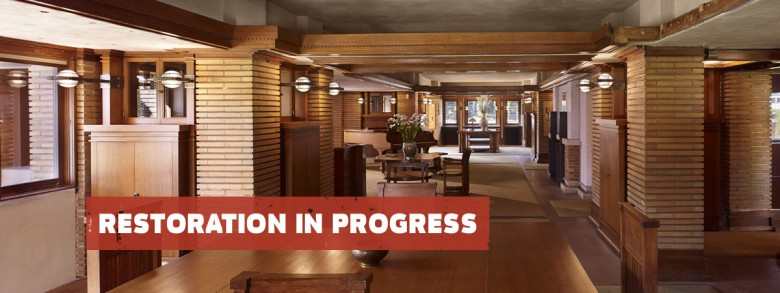Have you ever taken a walking tour of the Darwin Martin House? If not, here are five surprising reasons to do so that I discovered recently during a tour hosted by Bryan Smith, one of 400 volunteers. No, that's not a typo. There are 400 trained docents at the Martin House. And it's a good thing. Tens of thousands of tourists visit this iconic structure every year. Volunteer here.
Five Ways in which Buffalo's Frank Lloyd Wright-Designed Darwin Martin House will Surprise You
Horizontal orientation and gutter innovation
In the 1900s, tall and narrow buildings were the standard. The iconoclastic Frank Lloyd Wright deviated intentionally from the era’s default, rejecting a narrow urban lot on Oakland Place owned by Mr. Martin and building instead on a much broader lot on the outskirts of the city. The Darwin Martin house is oriented along long horizontal lines with wide, shallow-pitched roofs, reminiscent of the construction of the American pioneer’s mudbrick huts on the Prairie. To allow drainage from the roof, rather than sully his horizontal focal points with pesky vertical gutters, he created his own series of custom-designed vertical gutters that were cleverly enclosed within conspicuous horizontal strips. Rain water and melting snow runoff is funneled into the sewer system without interrupting the continuity of his aesthetic.
Seamless windows, innovative window frames
Wright was plagued by the technical restraints of the early 20th century. He had a grand vision to create windows that could swing open, with no seams separating them for the Darwin Martin house. But wooden cladding was needed to support the weight of the windows, which limited the continuity Wright was striving for. Then he implemented a window design for Graycliff, the Martin's house on Lake Erie also designed by Wright, that features windows that flow together somewhat more seamlessly using innovative materials. Finally, Wright’s Fallingwater, constructed in 1935, featured windows with light panes between them that fulfilled Wright’s vision of aesthetic continuity the most effectively.
Distinctly American architecture, egalitarianism
While class distinctions were pronounced in the early 20th century, Wright’s decision to adorn the Gardener’s Cottage on the Darwin Martin house property with art-glass windows reflected his egalitarian attitude toward the working man, who he believed was deserving of beauty, just as the landscape architect Frederick Law Olmsted believed the common man was entitled to accesss to nature. Another egalitarian design feature is found in the kitchen: the curved tile is easier for servants to clean than tile set at right angles. The kitchen is also large and spacious, which made life easier for the servants, and was adorned with white walls. While this might sound like more upkeep, it actually reflects the then recent developments in germ theory, and represents a sanitary space. There is also considerable shelving. The original kitchen cabinets were moved to a house on Ashland by Mrs. Martin, who could no longer afford to maintain the house during the Great Depression and the loss of Mr. Martin’s considerable personal fortune. During a tour, the owner of the Ashland house realized that the original Darwin Martin house cabinets were installed in her kitchen and graciously donated them back to the property.
Hundreds of windows
There are 400 windows in the Darwin Martin House, many of which were originally adorned with costly art-glass with patterns custom-designed by Wright. One window might contain more than 700 individual pieces of glass. Our tour guide said the restoration of a single window could cost more than $25,000 because of the intricate nature of the task.
Most significant commission without budget restraints
The Darwin Martin house was one of Wright’s most significant commissions. The project set his career in motion and generated significant notoriety. He developed a lifelong friendship with his patron, Mr. Martin, an accountant and executive for the Larkin Soap Company. The project was also notable because Wright wasn’t held to the same stringent budgetary constraints which restrained his other projects, and he went over budget twice, much to Mrs. Martin's great consternation.
The exploration of this extraordinary property is a good use of a Sunday afternoon, although tours are also available daily except Tuesday. If you seek respite from beer, Bills, and bowling, don't wait until guests come to visit. Spend an afternoon at the Darwin Martin house.

